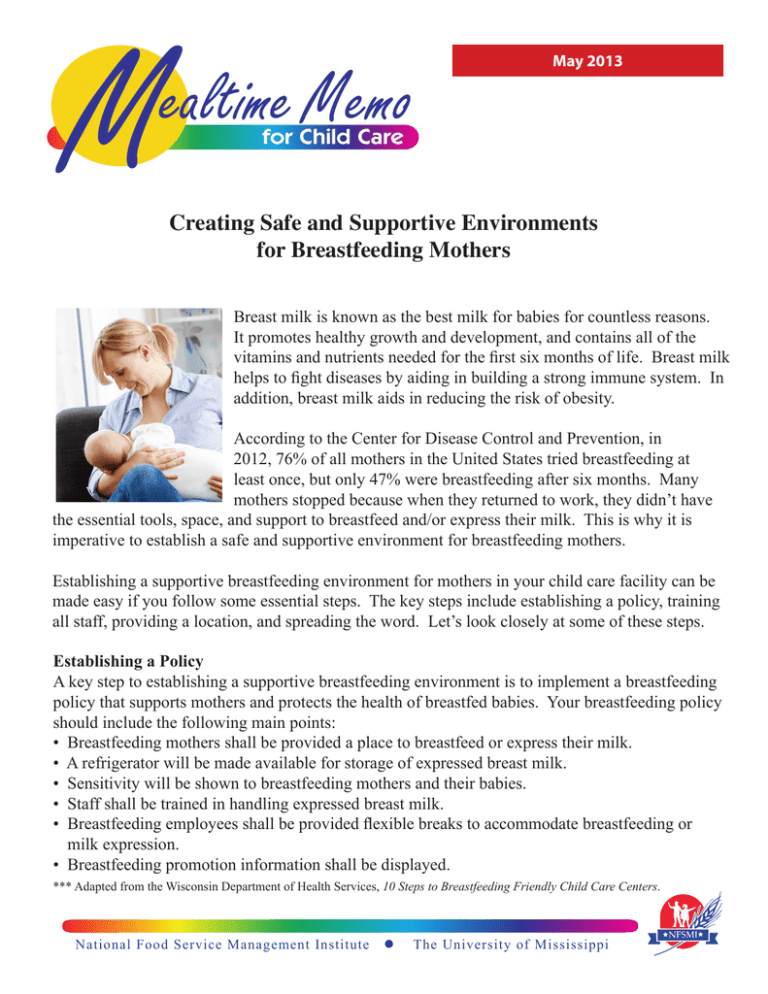Creating Safe and Supportive Environments for
advertisement

May 2013 for Child Care Creating Safe and Supportive Environments for Breastfeeding Mothers Breast milk is known as the best milk for babies for countless reasons. It promotes healthy growth and development, and contains all of the vitamins and nutrients needed for the first six months of life. Breast milk helps to fight diseases by aiding in building a strong immune system. In addition, breast milk aids in reducing the risk of obesity. According to the Center for Disease Control and Prevention, in 2012, 76% of all mothers in the United States tried breastfeeding at least once, but only 47% were breastfeeding after six months. Many mothers stopped because when they returned to work, they didn’t have the essential tools, space, and support to breastfeed and/or express their milk. This is why it is imperative to establish a safe and supportive environment for breastfeeding mothers. Establishing a supportive breastfeeding environment for mothers in your child care facility can be made easy if you follow some essential steps. The key steps include establishing a policy, training all staff, providing a location, and spreading the word. Let’s look closely at some of these steps. Establishing a Policy A key step to establishing a supportive breastfeeding environment is to implement a breastfeeding policy that supports mothers and protects the health of breastfed babies. Your breastfeeding policy should include the following main points: • Breastfeeding mothers shall be provided a place to breastfeed or express their milk. • A refrigerator will be made available for storage of expressed breast milk. • Sensitivity will be shown to breastfeeding mothers and their babies. • Staff shall be trained in handling expressed breast milk. • Breastfeeding employees shall be provided flexible breaks to accommodate breastfeeding or milk expression. • Breastfeeding promotion information shall be displayed. *** Adapted from the Wisconsin Department of Health Services, 10 Steps to Breastfeeding Friendly Child Care Centers. National Food Service Management Institute The University of Mississippi Providing a Location To create a quality breastfeeding area, designate a space for mothers. This space should not be located for Child Care in a restroom area due to the high levels of bacteria housed in restrooms. The area should be in a private May 2013, continued room with a door that can be locked for privacy. Include a chair for mothers to sit comfortably. Add signage for mothers to easily identify the designated area. Include other essentials, such as electrical outlets, a small table, and a waste basket. Mothers should also have access to a sink for hand washing and a specific refrigerated location for storing their expressed milk. Handling and Storing Expressed Milk Safely Discuss the breastfeeding policy for handling and storing expressed breast milk with mothers. Ask each mother to label the bottle with the child’s name, date, and time the milk was expressed. Also immediately after expressing, ask each mother to store their expressed milk in 2 - 4 ounce, hard plastic, labeled bottles in the back of a refrigerator or freezer. As a child care provider, always wash your hands for at least 20 seconds in warm soapy water before handling the expressed milk. If the expressed milk is frozen upon receipt, thaw in the refrigerator or in a container of warm water. Then use the thawed milk within 24 hours. Never microwave expressed milk as this may create hot spots that can burn the mouth of babies. Never refreeze milk or mix unfinished milk with new milk. For more information regarding expiration dates, fresh or frozen breast milk, or related questions, consult with your local and state authorities for applicable health and safety regulations regarding the safe handling of expressed breast milk. For more information about creating a supportive breastfeeding child care environment, check out 10 Steps to Breastfeeding Friendly Child Care Centers resource at http://www.dhs.wisconsin.gov/ health/physicalactivity/pdf_files/BreastfeedingFriendlyChildCareCenters.pdf Nutrition Tip of the Month According to the National Resource Center for Health and Safety in Child Care and Early Education, the recommended concentration of bleach in a sanitizing solution has changed from 5.25%-6% to 8.25% in many areas across the country. If you use bleach and water as a sanitizer, check with your local or state health department to determine if there are any changes needed for mixing the bleach and water solution. Nutrition Fact of the Month Milk is made up of at least 7 minerals, 11 vitamins, and 88% water. Take a minute and drink a glass of low-fat or fat-free milk to increase your mineral, vitamin, and water intake. for Child Care May 2013, continued Fruit of the Month It’s Fruit Time! The fruit of the month is the strawberry. There are over 70 varieties of strawberries, and in the United States over 83% are produced in the state of California. Unlike other fruits, strawberries are picked by hand to protect their quality. Strawberries are in season April through October. Some easy ideas for introducing strawberries include visiting a strawberry farm, inviting a local farmer to talk about strawberries, and planting strawberries in pots for children to watch as they grow. It’s News Time National Physical Fitness and Sports Month May is National Physical Fitness and Sports Month, sponsored by the President’s Council on Fitness, Sports, and Nutrition (PCFSN). During this month, PCFSN promotes the value of physical activity and implementing healthy eating behaviors. Also during this month, the PCFSN seeks to “engage, educate, and empower” all Americans in adopting and living a healthier lifestyle. To obtain more information follow the link: http://healthfinder.gov/nho/MayToolkit.aspx If you have other news that you wish to share, email us at nfsmi@olemiss.edu. This project has been funded at least in part with Federal funds from the U.S. Department of Agriculture, Food and Nutrition Service through a grant agreement with The University of Mississippi. The contents of this publication do not necessarily reflect the views or policies of the U.S. Department of Agriculture, nor does mention of trade names, commercial products, or organizations imply endorsement by the U.S. Government. The University of Mississippi is an EEO/AA/Title VI/Title IX/Section 504/ADA/ADEA Employer. for Child Care National Food Service Management Institute May 2013, continued CACFP Rock Star of the Month The CACFP Rock Star of the Month is Ms. Marie Farmer. Ms. Farmer is the Owner and Director of Farmer Family Preschool, a family child care home in North Carolina. Ms. Farmer finds passion in preparing healthy foods from scratch and serving them in appealing ways. She prefers to plan her menus based on the curriculum’s weekly theme to reinforce the educational theme and to establish healthy eating habits at an early age. For example, during Transportation Week, Ms. Farmer cut cooked carrots in circles and served them as carrot wheels. In addition, Ms. Farmer embraces family style dining by incorporating table cloths, center pieces, and child-sized utensils for meals. Ms. Farmer also has an onsite garden where she grows fruits and vegetables to be served to the children in her care. After experiencing Hurricane Irene, many of her trees near the garden were demolished. She applied for a grant and was approved to plant 50 new trees for the children to obtain a better understanding of how plants grow. Congratulations Ms. Farmer! You are truly a CACFP Rock Star. Sources Center for Disease Control and Prevention. (2012). Breastfeeding report card 2012, united states: Outcome indicators. Retrieved from http://www.cdc.gov/breastfeeding/data/reportcard2.htm National Food Service Management Institute. (2009). Child care fact sheet: Handwashing for children and staff. Retrieved from http://www.nfsmi.org/documentlibraryfiles/PDF/20100419043741.pdf National Resource Center for Health and Safety in Child Care and Early Education. (2013). New important information about new bleach concentration. Retrieved from http://nrckids.org/ University of Nebraska – Lincoln Extention. (n.d.). Fruit and vegetable fact sheets. Retrieved from http:// lancaster.unl.edu/nep/fruvegc.pdf United States Department of Agriculture, Agricultural Research Service. (2012). USDA national nutrient database for standard reference, release 25. Retrieved from http://ndb.nal.usda.gov/ Wisconsin Department of Public Health Services. (2009). 10 steps to breastfeeding friendly child care centers resource kit. Retrieved from http://www.dhs.wisconsin.gov/health/physicalactivity/pdf_files/Breastfeeding FriendlyChildCareCenters.pdf In accordance with Federal law and U.S. Department of Agriculture policy, this institution is prohibited from discriminating on the basis of race, color, national origin, sex, age, or disability. To file a complaint of discrimination, write USDA, Director, Office of Civil Rights; Room, 326-W, Whitten Building, 1400 Independence Avenue, SW, Washington, DC 20250-9410 or call (202) 720-5964 (voice and TDD). USDA is an equal opportunity provider and employer.”
